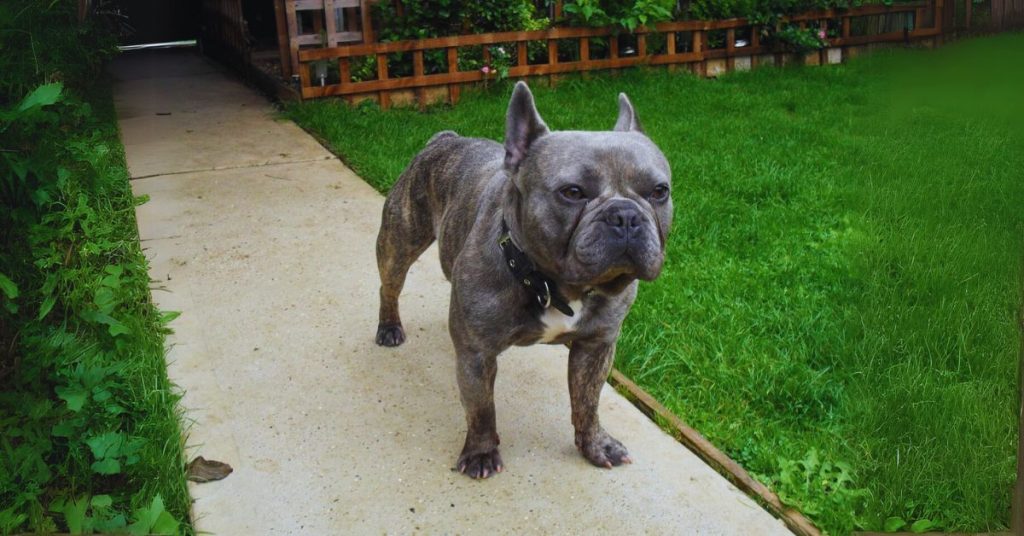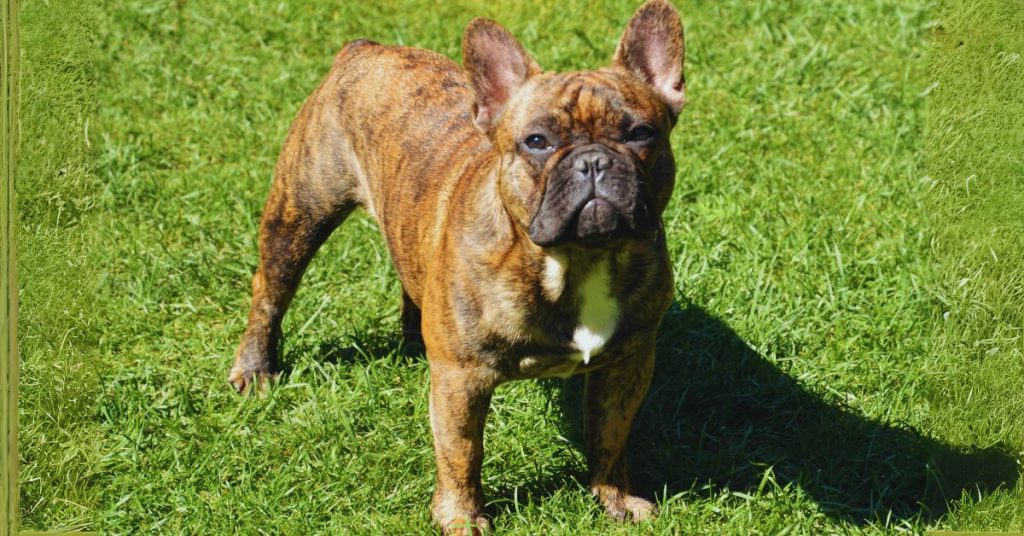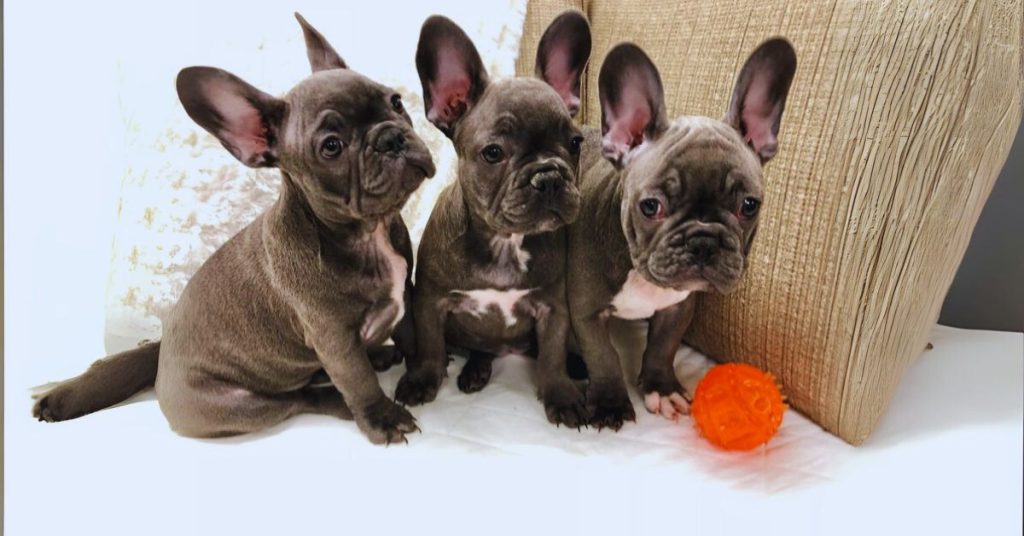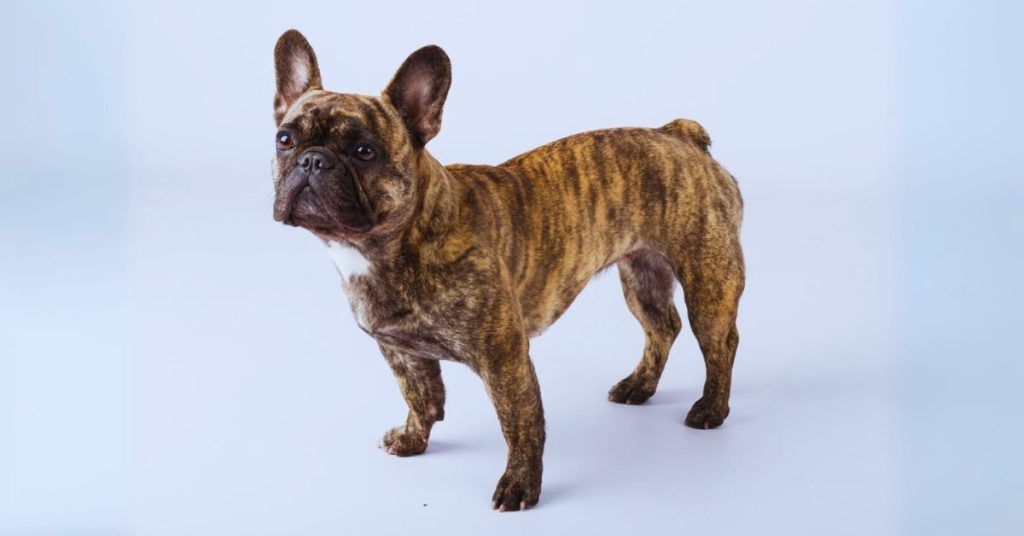Brindle is one of the many coat colors and patterns available for Brindle French Bulldog. Dogs with a brindle coat pattern have darker stripes over a base color that is either reddish or brown. Although it is a typical French Bulldog coloring pattern, it is undoubtedly one of the most eye-catching. Color aside, let’s take a closer look at the History of all Frenchies, which is as colorful and eccentric as they are!
What Is A French Bulldog Brindle?
A French bulldog brindle is a dog with a coat that is streaked or striped due to the combination of light and dark hairs. With the brindle pattern overlaid, the coat’s base color—which can vary—is usually fawn, cream, chocolate, or black. The degree of brindling in brindle French Bulldogs can vary from a faint striped pattern to a more noticeable and eye-catching pattern.
Brindle is a popular and well-known color for French Bulldogs. It enhances their distinctive and endearing look. Because of their unique bat-like ears, fun disposition, and loving temperament, Brindle French Bulldogs are adored by individuals and families.
Brindle French Bulldogs share many traits with other French Bulldogs, such as their joyful disposition, bat-like ears, and loving attitude. But what distinguishes them and makes them stand out is their distinctive brindle coat pattern.
One possible trait of brindle French Bulldogs is that they can have a wide range of brindle patterns; some may be more subtle and blended, while others may be more obvious and definite. Each brindle Frenchie has a different coat pattern, contributing to their originality and appeal.
Brindle French Bulldogs are adored for their affectionate natures and make excellent companions for individuals and families, regardless of differences in coat pattern. They are a pleasure to be around due to their playful and devoted temperament, and their distinctive coat pattern only increases their allure.
The Earliest Records of Overweight French Bulldog in History

Bulldog breeders discovered a new source of income when blood sports were outlawed in Britain in 1835: producing dogs for exhibition. At these events, small bulldogs became known as “Toy Bulldogs.”
During the Industrial Revolution, the smaller dogs traveled to France, where they became increasingly popular. Although the first known photograph of a brindle Frenchie was taken in 1901, they were undoubtedly present long before that.
How French Bulldog Muscular Gained Popularity?
Skilled artisans fled Britain for northern France, where there was still a need for skilled lace workers when the Industrial Revolution began to replace human labor with machines and displace experienced artisans. They were accompanied by their canine friends and tiny toy Bulldogs throughout the trip.
The popularity of toy bulldogs skyrocketed in France, and breeders began importing them from Britain to meet the demand. The dogs they submitted were called “Bouledogue Français,” or “French Bulldog,” because they didn’t meet the Bulldog breed standard, English bulldog puppies for sale without papers, which calls for dogs with sticky-uppy ears and short stature.
People from many walks of life, including wealthy socialites and those on the periphery of society, immediately adopted these canines as friends. In Montmartre, which at the time had several brothels, it was not unusual to see a Frenchie running along at the heels of nightlife girls in Paris.
Because Brindle is a widespread coat color pattern, it was likely one of the most popular French Bulldog coat colors at the time.
What Exactly is a Lilac Brindle French Bulldog?

A brindle French Bulldog’s black base coat with bright, uneven streaks that help you identify them. In contrast to the base coat, which is typically black but can also be blue, chocolate, or lilac, the brindle pattern is typically a light shade of fawn. Brindle Frenchies can be extremely dark or light, depending on their black and fawn hair proportions.
They typically have dark eyes and a black nose. The most traditional and prevalent pattern among French Bulldogs is brindle. Along with fawn, white, and pied (as opposed to blue, chocolate, and lilac colors), it remains one of the few colors and patterns that kennel clubs still approve of. Therefore, a black brindle Frenchie can be the right choice if you intend to compete in dog shows with your puppy!
Formal Recognition of Full Grown Black French Bulldog
The American Kennel Club officially recognized French Bulldogs in 1898. In Britain, French Bulldogs were not considered distinct from English Bulldogs until 1905.
Along with pied and fawn, bristle is one of the coat colors recognized by the American Kennel Club.
Does a Drawing of a French Bulldog Make a Good Pet?
Because of their playful and loving personality, French Bulldogs of all colors are wonderful companions. Many are amiable with outsiders and enjoy spending time with their families. However, their short noses and flat features make them vulnerable to diseases like brachycephalic airway syndrome, which causes snoring and noisy breathing in mild cases.
In extreme situations, individuals could breathe even louder than normal and experience fatigue during hot weather or physical activity. The strain of exercise can cause some dogs to collapse, and they may cough, gag, or throw up. Additionally, french bulldog weight is prone to separation anxiety and develop strong bonds with their families.
What Are The Different Types of French Bulldog Puppies?
Each color and pattern of a fluffy French bulldog has its distinct charm. Here are a few typical kinds:
Black Brindle: Brindle-in-black French Bulldogs have a dark base coat with a striped fawn and black hair pattern. Some dogs have a more noticeable brindle pattern than others, and the severity of the pattern can vary.
Chocolate Brindle: A rindle of chocolate. French bulldogs’ coats blend fawn and chocolate (dark brown) hairs to create a striped pattern with a deep, chocolaty foundation color. Like black brindles, chocolate brindle Frenchies can differ in how intense the pattern is.
Blue Brindle: A blue brindle. French bulldogs’ coats blend fawn and blue (gray) hairs to create a striped pattern with a blue-toned base color. Though usually less noticeable than other brindle varieties, the blue brindle pattern is eye-catching.
Reverse Brindle: Brindle in reverse French Bulldogs appear to have a dark coat with lighter stripes because the dark brindle stripes are more noticeable than the lighter base color. This inverted design can produce an eye-catching and distinctive appearance.
French bulldog lifespan is popular among dog enthusiasts since each variety has distinct beauty and charm. Regardless of breed, They are renowned for their affectionate dispositions and excellent companionship for individuals and families.
Where to Get a French Bulldog For Sale?
Getting a blue French bulldog involves considering breeders, adopting, and finding a suitable pet supplier. Here’s a closer look at each possibility.
Adoption
Getting a long haired french bulldog can be a rewarding and economical decision. Many rescue groups focus on French Bulldogs, including local breed-specific rescues and the French Bulldog Rescue Network (FBRN). French bulldog rescue in need of homes are frequently found at shelters; some even provide purebred dogs. In addition to saving a dog, this decision also lessens the financial strain of purchasing from breeders.
Breeders
It is essential to confirm the legitimacy of breeders before making a purchase. Look for breeders who are members of respectable organizations such as (AKC) the American Kennel Club. Reputable breeders offer thorough lineage information and health clearances. Verify the breeder follows moral guidelines, such as ensuring puppies are socialized appropriately and checking for common health conditions genetically. The future health and disposition of the dog can be inferred by visiting the breeder’s facility, seeing the living conditions of the puppies, and meeting the puppy’s parents. To guarantee a happy and healthy companion, look for a mini French bulldog through adoption or trustworthy breeders.
Best Names for a French Bulldog Adoption Near Me

Selecting the ideal name for your French bulldog allergies may be enjoyable and fulfilling. Names like “Tiger” or “Stripe” can draw attention to their unusual appearance because of their remarkable coat patterns and endearing dispositions. Names like “Bruno” or “Luna,” which fit their dignified manner, might add a touch of refinement. The songs “Ziggy” and “Pepper” can be ideal if you’re searching for something lighthearted. Ultimately, the ideal name is the one that you and your new pet feel comfortable with. A well-chosen name enhances your relationship with your French bulldog adult, reflecting their special qualities.
Consultation
The French Bulldog has one of the most fascinating histories of all the breeds. Having been bred exclusively as companion dogs, they have remained devoted companions to several dog parents across continents for decades.
We strongly advise you to consider adoption if you’re considering getting a French Bulldog. Many organizations and rehoming centers are still looking for loving homes for gorgeous Frenchies, even though they differ from the breed most frequently encountered in shelters.
Frequently Asked Questions
Are Brindle French Bulldogs Healthy?
The Brindle includes other members of their breed. French Bulldogs may experience health problems, including allergies, hip dysplasia, and brachycephalic airway syndrome. Proper care and routine veterinary examinations can help manage these illnesses.
How much is an AKC French Bulldog Worth?
Buying an adoption French bulldog pup from a breeder often costs between $1,500 and $7,000. This price is common and based on rarity, as French Bulldogs from breeders are rarely advertised for less than $1,500. Naturally, Frenchies with unique coat hues will cost extra. For instance, the cost of a blue-brindle French Bulldog is likely higher than that of a typical brindle Frenchie.
How to tell if a Frenchie is Purebred?
Short legs, a flat face, a flattened nose, big dark eyes, a strong physique, bat-like ears, a dome-shaped head, and a short, corkscrew tail are all characteristics of a genuine Frenchie.
Are Brindle French Bulldogs Rare?
No. The French Bulldog breed naturally produces Brindle’s reasonably widespread and classic color variant. Although Brindle is not regarded as a rare French Bulldog color, some breeders will make this claim to raise prices.
